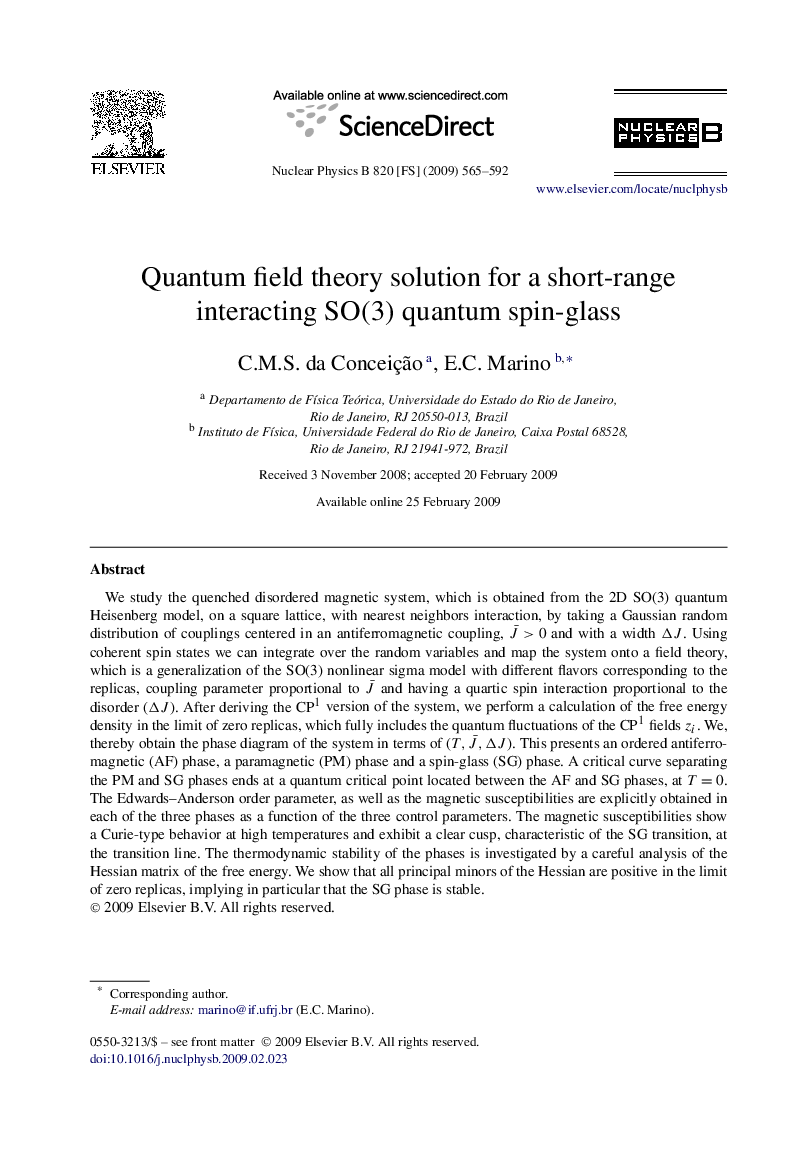| کد مقاله | کد نشریه | سال انتشار | مقاله انگلیسی | نسخه تمام متن |
|---|---|---|---|---|
| 1843467 | 1527772 | 2009 | 28 صفحه PDF | دانلود رایگان |
عنوان انگلیسی مقاله ISI
Quantum field theory solution for a short-range interacting SO(3) quantum spin-glass
دانلود مقاله + سفارش ترجمه
دانلود مقاله ISI انگلیسی
رایگان برای ایرانیان
موضوعات مرتبط
مهندسی و علوم پایه
ریاضیات
فیزیک ریاضی
پیش نمایش صفحه اول مقاله

چکیده انگلیسی
We study the quenched disordered magnetic system, which is obtained from the 2D SO(3) quantum Heisenberg model, on a square lattice, with nearest neighbors interaction, by taking a Gaussian random distribution of couplings centered in an antiferromagnetic coupling, J¯>0 and with a width ÎJ. Using coherent spin states we can integrate over the random variables and map the system onto a field theory, which is a generalization of the SO(3) nonlinear sigma model with different flavors corresponding to the replicas, coupling parameter proportional to J¯ and having a quartic spin interaction proportional to the disorder (ÎJ). After deriving the CP1 version of the system, we perform a calculation of the free energy density in the limit of zero replicas, which fully includes the quantum fluctuations of the CP1 fields zi. We, thereby obtain the phase diagram of the system in terms of (T,J¯,ÎJ). This presents an ordered antiferromagnetic (AF) phase, a paramagnetic (PM) phase and a spin-glass (SG) phase. A critical curve separating the PM and SG phases ends at a quantum critical point located between the AF and SG phases, at T=0. The Edwards-Anderson order parameter, as well as the magnetic susceptibilities are explicitly obtained in each of the three phases as a function of the three control parameters. The magnetic susceptibilities show a Curie-type behavior at high temperatures and exhibit a clear cusp, characteristic of the SG transition, at the transition line. The thermodynamic stability of the phases is investigated by a careful analysis of the Hessian matrix of the free energy. We show that all principal minors of the Hessian are positive in the limit of zero replicas, implying in particular that the SG phase is stable.
ناشر
Database: Elsevier - ScienceDirect (ساینس دایرکت)
Journal: Nuclear Physics B - Volume 820, Issue 3, 21 October 2009, Pages 565-592
Journal: Nuclear Physics B - Volume 820, Issue 3, 21 October 2009, Pages 565-592
نویسندگان
C.M.S. da Conceição, E.C. Marino,